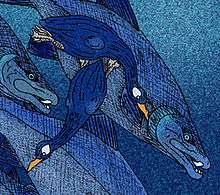Chendytes
| Chendytes Temporal range: Late Pleistocene - Mid Holocene | |
|---|---|
 | |
| Chendytes lawi and Oncorhynchus rastrosus | |
| Scientific classification | |
| Kingdom: | Animalia |
| Phylum: | Chordata |
| Class: | Aves |
| Order: | Anseriformes |
| Family: | Anatidae |
| Subfamily: | Merginae |
| Genus: | †Chendytes |
| Species: | †C. lawi |
| Binomial name | |
| Chendytes lawi Miller 1925[1] | |
Chendytes lawi was a goose-sized flightless sea duck, once common on the California coast, California Channel Islands, and possibly southern Oregon. It lived in the Pleistocene and survived into the Holocene. It appears to have gone extinct at about 450–250 BCE.[2] The youngest direct radiocarbon date from a Chendytes bone fragment dates to 770–400 BCE and was found in an archeological site in Ventura County. Its remains have been found in fossil deposits and in early coastal archeological sites. Archeological data from coastal California show a record of human exploitation of Chendytes lawi for at least 8,000 years.[2] It was probably driven to extinction by hunting, animal predation, and loss of habitat. There is nothing in the North American archaeological record indicating a span of exploitation for any megafaunal genera remotely as long as that of Chendytes.[2]
References
- ↑ Miller, Loye H. (1925). "Chendytes, a Diving Goose from the California Pleistocene" (PDF). Condor. 27 (4): 145–147. doi:10.2307/1362992. JSTOR 1362992.
- 1 2 3 Jones, T.L.; et al. (2008). "The protracted Holocene extinction of California's flightless sea duck (Chendytes lawi) and its implications for the Pleistocene overkill hypothesis". Proceedings of the National Academy of Sciences of the United States of America. 105 (11): 4105–4108. doi:10.1073/pnas.0711140105. PMC 2393816
 . PMID 18334640.
. PMID 18334640.